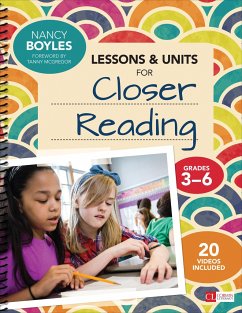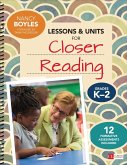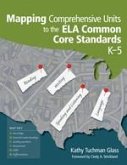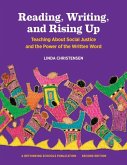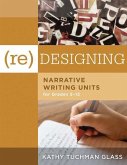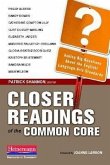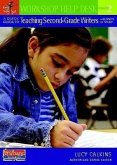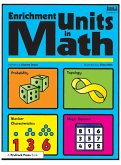Nancy N Boyles
Lessons and Units for Closer Reading, Grades 3-6
Ready-To-Go Resources and Planning Tools Galore
Nancy N Boyles
Lessons and Units for Closer Reading, Grades 3-6
Ready-To-Go Resources and Planning Tools Galore
- Broschiertes Buch
- Merkliste
- Auf die Merkliste
- Bewerten Bewerten
- Teilen
- Produkt teilen
- Produkterinnerung
- Produkterinnerung
* *
Andere Kunden interessierten sich auch für
![Lessons and Units for Closer Reading, Grades K-2 Lessons and Units for Closer Reading, Grades K-2]() Nancy N BoylesLessons and Units for Closer Reading, Grades K-245,99 €
Nancy N BoylesLessons and Units for Closer Reading, Grades K-245,99 €![Mapping Comprehensive Units to the Ela Common Core Standards, K-5 Mapping Comprehensive Units to the Ela Common Core Standards, K-5]() Kathy Tuchman GlassMapping Comprehensive Units to the Ela Common Core Standards, K-551,99 €
Kathy Tuchman GlassMapping Comprehensive Units to the Ela Common Core Standards, K-551,99 €![Reading, Writing, and Rising Up: Teaching about Social Justice and the Power of the Written Word Volume 2 Reading, Writing, and Rising Up: Teaching about Social Justice and the Power of the Written Word Volume 2]() Linda ChristensenReading, Writing, and Rising Up: Teaching about Social Justice and the Power of the Written Word Volume 223,99 €
Linda ChristensenReading, Writing, and Rising Up: Teaching about Social Justice and the Power of the Written Word Volume 223,99 €![(Re)Designing Narrative Writing Units for Grades 5-12 (Re)Designing Narrative Writing Units for Grades 5-12]() Kathy Tuchman Glass(Re)Designing Narrative Writing Units for Grades 5-1236,99 €
Kathy Tuchman Glass(Re)Designing Narrative Writing Units for Grades 5-1236,99 €![Closer Readings of the Common Core Closer Readings of the Common Core]() Closer Readings of the Common Core36,99 €
Closer Readings of the Common Core36,99 €![A Quick Guide to Teaching Second-Grade Writers with Units of Study A Quick Guide to Teaching Second-Grade Writers with Units of Study]() Lucy CalkinsA Quick Guide to Teaching Second-Grade Writers with Units of Study14,99 €
Lucy CalkinsA Quick Guide to Teaching Second-Grade Writers with Units of Study14,99 €![Enrichment Units in Math Book 3 Enrichment Units in Math Book 3]() Dianne DrazeEnrichment Units in Math Book 322,99 €
Dianne DrazeEnrichment Units in Math Book 322,99 €-
-
-
* *
Hinweis: Dieser Artikel kann nur an eine deutsche Lieferadresse ausgeliefert werden.
Hinweis: Dieser Artikel kann nur an eine deutsche Lieferadresse ausgeliefert werden.
Produktdetails
- Produktdetails
- Verlag: Sage Publications
- Seitenzahl: 336
- Erscheinungstermin: 3. Februar 2015
- Englisch
- Abmessung: 277mm x 231mm x 25mm
- Gewicht: 930g
- ISBN-13: 9781483375670
- ISBN-10: 1483375676
- Artikelnr.: 42200732
- Herstellerkennzeichnung
- Produktsicherheitsverantwortliche/r
- Europaallee 1
- 36244 Bad Hersfeld
- gpsr@libri.de
- Verlag: Sage Publications
- Seitenzahl: 336
- Erscheinungstermin: 3. Februar 2015
- Englisch
- Abmessung: 277mm x 231mm x 25mm
- Gewicht: 930g
- ISBN-13: 9781483375670
- ISBN-10: 1483375676
- Artikelnr.: 42200732
- Herstellerkennzeichnung
- Produktsicherheitsverantwortliche/r
- Europaallee 1
- 36244 Bad Hersfeld
- gpsr@libri.de
A former classroom teacher and professor of reading, Nancy Boyles is a literacy consultant, who provides workshops, model lessons, and curriculum support to districts and organizations nationally, regionally, and locally. Over the course of her career she has received numerous awards , including New England Reading Association's Outstanding Literacy Leader Award and Connecticut Reading Association's Celebrate Literacy Award for exemplary service.
Foreword by Tanny McGregor
Acknowledgments
A Guide to Using the Lessons and Units
Chart: Learning Pathways, Units, and Anchor Texts
Teaching for Coherence: Why Moving From Stand-Alone Lessons to Units of
Study Matters
Picture Books as Mentor Texts
The Secret Weapon of This Book's Units: Learning Pathways
Chart: Teaching Units According to Learning Pathways
How Coherence Leads to Critical Thinking
Seven Criteria for Critical Thinking
The Ten Planning Steps for Each Unit: Tips for Success
Chart: A Visual Tour of the Units
Step 1. Identify Your Learning Pathway, Unit Focus, and Inquiry Question
Step 2. Select and Sequence Your Books
Chart: Quick Survey of Text Complexity
Chart: Choosing Powerful Picture Books
Step 3. Determine Your Reading Focus Standard for the Unit
Chart: Determining a Unit's Focus Standard
Step 4. Plan for Units of Approximately Five Weeks Using a Unit Curriculum
Map
Chart: Unit Curriculum Map for Studying ____
Step 5. Launch Your Unit With a Unit Preview and a Kickoff Lesson Based on
the Nonfiction Article Provided
Chart: Unit Preview Questions and Discussion Points
Chart: Questions to Link an Introductory Short Text to a Unit of Study
Step 6. Study One Picture Book Per Week, Beginning With an Initial Close
Reading Lesson Where You Discuss The Entire Book
Chart: Close Reading Lesson Components, Links to Video, and Hot Tips for
Close Reading Success
Step 7. Revisit the Text for Follow-Up Standards-Based Skill or Strategy
Lessons
Template: Follow-Up Skill or Strategy Lesson
Exemplar Lesson: Follow-Up Lesson for The Raft
Exemplar Graphic Organizer: Describe a Character or Person
Step 8. Link the Books to One Another Through Discussion and Written
Response
Chart: Discussion Questions for Text-to-Text Connections
Step 9. Administer Two Assessment Tasks at the End of Each Unit
(Content-Based and Standards-Based)
Distinguishing Between the Content-Based and Standards-Based Assessments
Chart: Rubric for Content-Based Assessment (Task 1) and Standards-Based
Assessment (Task 2)
Chart: Interpretation of Rubric Data
Chart: Rubric for Measuring Students' Critical Thinking: Talking and
Writing About Sources
Step 10. Analyze Student Work
Template: Reflecting on Reading Responses for Individual Students
Template: Reflecting on Class Performance for a Close Reading Follow-Up
Task
Reflection Questions for the Ten Steps of Unit Planning and Teaching
The Units and Lessons
How to Study a Concept: What Makes Someone a Good Leader?
Introduction to the Unit
Unit Curriculum Map for Close Reading
Short Informational Text: To Be a Leader
Close Reading Lessons for Weslandia
Close Reading Lessons for Testing the Ice: A True Story About Jackie
Robinson
Close Reading Lessons for Night Flight: Amelia Earhart Crosses the Atlantic
Close Reading Lessons for Nelson Mandela
How to Study a Person: Who Was Abraham Lincoln: Boy, Husband, Father,
President?
Introduction to the Unit
Unit Curriculum Map for Close Reading
Short Informational Text: Selected Quotes by Abraham Lincoln
Close Reading Lessons for Honest Abe
Close Reading Lessons for Looking at Lincoln
Close Reading Lessons for Abraham Lincoln Comes Home
Close Reading Lessons for Abe's Honest Words: The Life of Abraham Lincoln
How to Study a Topic: How Do You Prefer to See the Moon-As an Astronomer,
an Astronaut, a Native American, or a Storyteller?
Introduction to the Unit
Unit Curriculum Map for Close Reading
Short Informational Text: Reflections on the Moon and Astronomy
Close Reading Lessons for Faces of the Moon
Close Reading Lessons for Thirteen Moons on Turtle's Back
Close Reading Lessons for Moonshot: The Flight of Apollo 11
Close Reading Lessons for The Man in the Moon
How to Study a Genre: How Many Ways Can You Tell a Fairy Tale?
Introduction to the Unit
Unit Curriculum Map for Close Reading
Short Informational Text: Why We Need Fairytales
Close Reading Lessons for The Princess and the Pizza
Close Reading Lessons for The Cowboy and the Black-Eyed Pea
Close Reading Lessons for Extra! Extra!: Fairy-Tale News From Hidden Forest
Close Reading Lessons for Once Upon a Cool Motorcycle Dude
How to Study an Author: How Does Robert Burleigh Write Such Interesting
Informational Books?
Introduction to the Unit
Unit Curriculum Map for Close Reading
Short Informational Text: Robert Burleigh Talks About His Writing
Close Reading Lessons for Home Run: The Story of Babe Ruth
Close Reading Lessons for Flight: The Journey of Charles Lindbergh
Close Reading Lessons for Look Up! Henrietta Leavitt, Pioneering Woman
Astronomer
Close Reading Lessons for Tiger of the Snows: Tenzing Norgay: The Boy Whose
Dream Was Everest
How to Study a Time in History: What Choices Would You Make if You Were a
Slave Child?
Introduction to the Unit
Unit Curriculum Map for Close Reading
Short Informational Text: Slave Holder's Diary
Close Reading Lessons for Minty: A Story of Young Harriet Tubman
Close Reading Lessons for Sojourner Truth's Step-Stomp Stride
Close Reading Lessons for Now Let Me Fly: The True Story of a Slave Family
Close Reading Lessons for Up the Learning Tree
How to Study a Theme: What Makes Home So Special?
Introduction to the Unit
Unit Curriculum Map for Close Reading
Short Informational Text: My Home
Close Reading Lessons for Let's Go Home: The Wonderful Things About a House
Close Reading Lessons for Going Home
Close Reading Lessons for A Thirst for Home: A Story of Water Across the
World
Close Reading Lessons for On This Spot: An Expedition Back Through Time
How to Study a Current Issue: What's the Big Deal About Clean Water?
Introduction to the Unit
Unit Curriculum Map for Close Reading
Short Informational Text: Water, Water Everywhere, but Not a Drop to
(Safely) Drink
Close Reading Lessons for A River Ran Wild
Close Reading Lessons for A Life Like Mine (excerpt)
Close Reading Lessons for One Well: The Story of Water on Earth (excerpt)
Close Reading Lessons for The Boy Who Harnessed the Wind
The End of the Story: Reflecting on Student Work
From New Haven, Connecticut
From Belfast, Maine
From Naugatuck, Connecticut
More From Naugatuck, Connecticut
From Meriden, Connecticut
From Greenland, New Hampshire
From North Haven, Connecticut
More From North Haven, Connecticut
Reflecting on Trends
Exemplars: Reflecting on Class Performance for a Close Reading Follow-Up
Task
References
Acknowledgments
A Guide to Using the Lessons and Units
Chart: Learning Pathways, Units, and Anchor Texts
Teaching for Coherence: Why Moving From Stand-Alone Lessons to Units of
Study Matters
Picture Books as Mentor Texts
The Secret Weapon of This Book's Units: Learning Pathways
Chart: Teaching Units According to Learning Pathways
How Coherence Leads to Critical Thinking
Seven Criteria for Critical Thinking
The Ten Planning Steps for Each Unit: Tips for Success
Chart: A Visual Tour of the Units
Step 1. Identify Your Learning Pathway, Unit Focus, and Inquiry Question
Step 2. Select and Sequence Your Books
Chart: Quick Survey of Text Complexity
Chart: Choosing Powerful Picture Books
Step 3. Determine Your Reading Focus Standard for the Unit
Chart: Determining a Unit's Focus Standard
Step 4. Plan for Units of Approximately Five Weeks Using a Unit Curriculum
Map
Chart: Unit Curriculum Map for Studying ____
Step 5. Launch Your Unit With a Unit Preview and a Kickoff Lesson Based on
the Nonfiction Article Provided
Chart: Unit Preview Questions and Discussion Points
Chart: Questions to Link an Introductory Short Text to a Unit of Study
Step 6. Study One Picture Book Per Week, Beginning With an Initial Close
Reading Lesson Where You Discuss The Entire Book
Chart: Close Reading Lesson Components, Links to Video, and Hot Tips for
Close Reading Success
Step 7. Revisit the Text for Follow-Up Standards-Based Skill or Strategy
Lessons
Template: Follow-Up Skill or Strategy Lesson
Exemplar Lesson: Follow-Up Lesson for The Raft
Exemplar Graphic Organizer: Describe a Character or Person
Step 8. Link the Books to One Another Through Discussion and Written
Response
Chart: Discussion Questions for Text-to-Text Connections
Step 9. Administer Two Assessment Tasks at the End of Each Unit
(Content-Based and Standards-Based)
Distinguishing Between the Content-Based and Standards-Based Assessments
Chart: Rubric for Content-Based Assessment (Task 1) and Standards-Based
Assessment (Task 2)
Chart: Interpretation of Rubric Data
Chart: Rubric for Measuring Students' Critical Thinking: Talking and
Writing About Sources
Step 10. Analyze Student Work
Template: Reflecting on Reading Responses for Individual Students
Template: Reflecting on Class Performance for a Close Reading Follow-Up
Task
Reflection Questions for the Ten Steps of Unit Planning and Teaching
The Units and Lessons
How to Study a Concept: What Makes Someone a Good Leader?
Introduction to the Unit
Unit Curriculum Map for Close Reading
Short Informational Text: To Be a Leader
Close Reading Lessons for Weslandia
Close Reading Lessons for Testing the Ice: A True Story About Jackie
Robinson
Close Reading Lessons for Night Flight: Amelia Earhart Crosses the Atlantic
Close Reading Lessons for Nelson Mandela
How to Study a Person: Who Was Abraham Lincoln: Boy, Husband, Father,
President?
Introduction to the Unit
Unit Curriculum Map for Close Reading
Short Informational Text: Selected Quotes by Abraham Lincoln
Close Reading Lessons for Honest Abe
Close Reading Lessons for Looking at Lincoln
Close Reading Lessons for Abraham Lincoln Comes Home
Close Reading Lessons for Abe's Honest Words: The Life of Abraham Lincoln
How to Study a Topic: How Do You Prefer to See the Moon-As an Astronomer,
an Astronaut, a Native American, or a Storyteller?
Introduction to the Unit
Unit Curriculum Map for Close Reading
Short Informational Text: Reflections on the Moon and Astronomy
Close Reading Lessons for Faces of the Moon
Close Reading Lessons for Thirteen Moons on Turtle's Back
Close Reading Lessons for Moonshot: The Flight of Apollo 11
Close Reading Lessons for The Man in the Moon
How to Study a Genre: How Many Ways Can You Tell a Fairy Tale?
Introduction to the Unit
Unit Curriculum Map for Close Reading
Short Informational Text: Why We Need Fairytales
Close Reading Lessons for The Princess and the Pizza
Close Reading Lessons for The Cowboy and the Black-Eyed Pea
Close Reading Lessons for Extra! Extra!: Fairy-Tale News From Hidden Forest
Close Reading Lessons for Once Upon a Cool Motorcycle Dude
How to Study an Author: How Does Robert Burleigh Write Such Interesting
Informational Books?
Introduction to the Unit
Unit Curriculum Map for Close Reading
Short Informational Text: Robert Burleigh Talks About His Writing
Close Reading Lessons for Home Run: The Story of Babe Ruth
Close Reading Lessons for Flight: The Journey of Charles Lindbergh
Close Reading Lessons for Look Up! Henrietta Leavitt, Pioneering Woman
Astronomer
Close Reading Lessons for Tiger of the Snows: Tenzing Norgay: The Boy Whose
Dream Was Everest
How to Study a Time in History: What Choices Would You Make if You Were a
Slave Child?
Introduction to the Unit
Unit Curriculum Map for Close Reading
Short Informational Text: Slave Holder's Diary
Close Reading Lessons for Minty: A Story of Young Harriet Tubman
Close Reading Lessons for Sojourner Truth's Step-Stomp Stride
Close Reading Lessons for Now Let Me Fly: The True Story of a Slave Family
Close Reading Lessons for Up the Learning Tree
How to Study a Theme: What Makes Home So Special?
Introduction to the Unit
Unit Curriculum Map for Close Reading
Short Informational Text: My Home
Close Reading Lessons for Let's Go Home: The Wonderful Things About a House
Close Reading Lessons for Going Home
Close Reading Lessons for A Thirst for Home: A Story of Water Across the
World
Close Reading Lessons for On This Spot: An Expedition Back Through Time
How to Study a Current Issue: What's the Big Deal About Clean Water?
Introduction to the Unit
Unit Curriculum Map for Close Reading
Short Informational Text: Water, Water Everywhere, but Not a Drop to
(Safely) Drink
Close Reading Lessons for A River Ran Wild
Close Reading Lessons for A Life Like Mine (excerpt)
Close Reading Lessons for One Well: The Story of Water on Earth (excerpt)
Close Reading Lessons for The Boy Who Harnessed the Wind
The End of the Story: Reflecting on Student Work
From New Haven, Connecticut
From Belfast, Maine
From Naugatuck, Connecticut
More From Naugatuck, Connecticut
From Meriden, Connecticut
From Greenland, New Hampshire
From North Haven, Connecticut
More From North Haven, Connecticut
Reflecting on Trends
Exemplars: Reflecting on Class Performance for a Close Reading Follow-Up
Task
References
Foreword by Tanny McGregor
Acknowledgments
A Guide to Using the Lessons and Units
Chart: Learning Pathways, Units, and Anchor Texts
Teaching for Coherence: Why Moving From Stand-Alone Lessons to Units of
Study Matters
Picture Books as Mentor Texts
The Secret Weapon of This Book's Units: Learning Pathways
Chart: Teaching Units According to Learning Pathways
How Coherence Leads to Critical Thinking
Seven Criteria for Critical Thinking
The Ten Planning Steps for Each Unit: Tips for Success
Chart: A Visual Tour of the Units
Step 1. Identify Your Learning Pathway, Unit Focus, and Inquiry Question
Step 2. Select and Sequence Your Books
Chart: Quick Survey of Text Complexity
Chart: Choosing Powerful Picture Books
Step 3. Determine Your Reading Focus Standard for the Unit
Chart: Determining a Unit's Focus Standard
Step 4. Plan for Units of Approximately Five Weeks Using a Unit Curriculum
Map
Chart: Unit Curriculum Map for Studying ____
Step 5. Launch Your Unit With a Unit Preview and a Kickoff Lesson Based on
the Nonfiction Article Provided
Chart: Unit Preview Questions and Discussion Points
Chart: Questions to Link an Introductory Short Text to a Unit of Study
Step 6. Study One Picture Book Per Week, Beginning With an Initial Close
Reading Lesson Where You Discuss The Entire Book
Chart: Close Reading Lesson Components, Links to Video, and Hot Tips for
Close Reading Success
Step 7. Revisit the Text for Follow-Up Standards-Based Skill or Strategy
Lessons
Template: Follow-Up Skill or Strategy Lesson
Exemplar Lesson: Follow-Up Lesson for The Raft
Exemplar Graphic Organizer: Describe a Character or Person
Step 8. Link the Books to One Another Through Discussion and Written
Response
Chart: Discussion Questions for Text-to-Text Connections
Step 9. Administer Two Assessment Tasks at the End of Each Unit
(Content-Based and Standards-Based)
Distinguishing Between the Content-Based and Standards-Based Assessments
Chart: Rubric for Content-Based Assessment (Task 1) and Standards-Based
Assessment (Task 2)
Chart: Interpretation of Rubric Data
Chart: Rubric for Measuring Students' Critical Thinking: Talking and
Writing About Sources
Step 10. Analyze Student Work
Template: Reflecting on Reading Responses for Individual Students
Template: Reflecting on Class Performance for a Close Reading Follow-Up
Task
Reflection Questions for the Ten Steps of Unit Planning and Teaching
The Units and Lessons
How to Study a Concept: What Makes Someone a Good Leader?
Introduction to the Unit
Unit Curriculum Map for Close Reading
Short Informational Text: To Be a Leader
Close Reading Lessons for Weslandia
Close Reading Lessons for Testing the Ice: A True Story About Jackie
Robinson
Close Reading Lessons for Night Flight: Amelia Earhart Crosses the Atlantic
Close Reading Lessons for Nelson Mandela
How to Study a Person: Who Was Abraham Lincoln: Boy, Husband, Father,
President?
Introduction to the Unit
Unit Curriculum Map for Close Reading
Short Informational Text: Selected Quotes by Abraham Lincoln
Close Reading Lessons for Honest Abe
Close Reading Lessons for Looking at Lincoln
Close Reading Lessons for Abraham Lincoln Comes Home
Close Reading Lessons for Abe's Honest Words: The Life of Abraham Lincoln
How to Study a Topic: How Do You Prefer to See the Moon-As an Astronomer,
an Astronaut, a Native American, or a Storyteller?
Introduction to the Unit
Unit Curriculum Map for Close Reading
Short Informational Text: Reflections on the Moon and Astronomy
Close Reading Lessons for Faces of the Moon
Close Reading Lessons for Thirteen Moons on Turtle's Back
Close Reading Lessons for Moonshot: The Flight of Apollo 11
Close Reading Lessons for The Man in the Moon
How to Study a Genre: How Many Ways Can You Tell a Fairy Tale?
Introduction to the Unit
Unit Curriculum Map for Close Reading
Short Informational Text: Why We Need Fairytales
Close Reading Lessons for The Princess and the Pizza
Close Reading Lessons for The Cowboy and the Black-Eyed Pea
Close Reading Lessons for Extra! Extra!: Fairy-Tale News From Hidden Forest
Close Reading Lessons for Once Upon a Cool Motorcycle Dude
How to Study an Author: How Does Robert Burleigh Write Such Interesting
Informational Books?
Introduction to the Unit
Unit Curriculum Map for Close Reading
Short Informational Text: Robert Burleigh Talks About His Writing
Close Reading Lessons for Home Run: The Story of Babe Ruth
Close Reading Lessons for Flight: The Journey of Charles Lindbergh
Close Reading Lessons for Look Up! Henrietta Leavitt, Pioneering Woman
Astronomer
Close Reading Lessons for Tiger of the Snows: Tenzing Norgay: The Boy Whose
Dream Was Everest
How to Study a Time in History: What Choices Would You Make if You Were a
Slave Child?
Introduction to the Unit
Unit Curriculum Map for Close Reading
Short Informational Text: Slave Holder's Diary
Close Reading Lessons for Minty: A Story of Young Harriet Tubman
Close Reading Lessons for Sojourner Truth's Step-Stomp Stride
Close Reading Lessons for Now Let Me Fly: The True Story of a Slave Family
Close Reading Lessons for Up the Learning Tree
How to Study a Theme: What Makes Home So Special?
Introduction to the Unit
Unit Curriculum Map for Close Reading
Short Informational Text: My Home
Close Reading Lessons for Let's Go Home: The Wonderful Things About a House
Close Reading Lessons for Going Home
Close Reading Lessons for A Thirst for Home: A Story of Water Across the
World
Close Reading Lessons for On This Spot: An Expedition Back Through Time
How to Study a Current Issue: What's the Big Deal About Clean Water?
Introduction to the Unit
Unit Curriculum Map for Close Reading
Short Informational Text: Water, Water Everywhere, but Not a Drop to
(Safely) Drink
Close Reading Lessons for A River Ran Wild
Close Reading Lessons for A Life Like Mine (excerpt)
Close Reading Lessons for One Well: The Story of Water on Earth (excerpt)
Close Reading Lessons for The Boy Who Harnessed the Wind
The End of the Story: Reflecting on Student Work
From New Haven, Connecticut
From Belfast, Maine
From Naugatuck, Connecticut
More From Naugatuck, Connecticut
From Meriden, Connecticut
From Greenland, New Hampshire
From North Haven, Connecticut
More From North Haven, Connecticut
Reflecting on Trends
Exemplars: Reflecting on Class Performance for a Close Reading Follow-Up
Task
References
Acknowledgments
A Guide to Using the Lessons and Units
Chart: Learning Pathways, Units, and Anchor Texts
Teaching for Coherence: Why Moving From Stand-Alone Lessons to Units of
Study Matters
Picture Books as Mentor Texts
The Secret Weapon of This Book's Units: Learning Pathways
Chart: Teaching Units According to Learning Pathways
How Coherence Leads to Critical Thinking
Seven Criteria for Critical Thinking
The Ten Planning Steps for Each Unit: Tips for Success
Chart: A Visual Tour of the Units
Step 1. Identify Your Learning Pathway, Unit Focus, and Inquiry Question
Step 2. Select and Sequence Your Books
Chart: Quick Survey of Text Complexity
Chart: Choosing Powerful Picture Books
Step 3. Determine Your Reading Focus Standard for the Unit
Chart: Determining a Unit's Focus Standard
Step 4. Plan for Units of Approximately Five Weeks Using a Unit Curriculum
Map
Chart: Unit Curriculum Map for Studying ____
Step 5. Launch Your Unit With a Unit Preview and a Kickoff Lesson Based on
the Nonfiction Article Provided
Chart: Unit Preview Questions and Discussion Points
Chart: Questions to Link an Introductory Short Text to a Unit of Study
Step 6. Study One Picture Book Per Week, Beginning With an Initial Close
Reading Lesson Where You Discuss The Entire Book
Chart: Close Reading Lesson Components, Links to Video, and Hot Tips for
Close Reading Success
Step 7. Revisit the Text for Follow-Up Standards-Based Skill or Strategy
Lessons
Template: Follow-Up Skill or Strategy Lesson
Exemplar Lesson: Follow-Up Lesson for The Raft
Exemplar Graphic Organizer: Describe a Character or Person
Step 8. Link the Books to One Another Through Discussion and Written
Response
Chart: Discussion Questions for Text-to-Text Connections
Step 9. Administer Two Assessment Tasks at the End of Each Unit
(Content-Based and Standards-Based)
Distinguishing Between the Content-Based and Standards-Based Assessments
Chart: Rubric for Content-Based Assessment (Task 1) and Standards-Based
Assessment (Task 2)
Chart: Interpretation of Rubric Data
Chart: Rubric for Measuring Students' Critical Thinking: Talking and
Writing About Sources
Step 10. Analyze Student Work
Template: Reflecting on Reading Responses for Individual Students
Template: Reflecting on Class Performance for a Close Reading Follow-Up
Task
Reflection Questions for the Ten Steps of Unit Planning and Teaching
The Units and Lessons
How to Study a Concept: What Makes Someone a Good Leader?
Introduction to the Unit
Unit Curriculum Map for Close Reading
Short Informational Text: To Be a Leader
Close Reading Lessons for Weslandia
Close Reading Lessons for Testing the Ice: A True Story About Jackie
Robinson
Close Reading Lessons for Night Flight: Amelia Earhart Crosses the Atlantic
Close Reading Lessons for Nelson Mandela
How to Study a Person: Who Was Abraham Lincoln: Boy, Husband, Father,
President?
Introduction to the Unit
Unit Curriculum Map for Close Reading
Short Informational Text: Selected Quotes by Abraham Lincoln
Close Reading Lessons for Honest Abe
Close Reading Lessons for Looking at Lincoln
Close Reading Lessons for Abraham Lincoln Comes Home
Close Reading Lessons for Abe's Honest Words: The Life of Abraham Lincoln
How to Study a Topic: How Do You Prefer to See the Moon-As an Astronomer,
an Astronaut, a Native American, or a Storyteller?
Introduction to the Unit
Unit Curriculum Map for Close Reading
Short Informational Text: Reflections on the Moon and Astronomy
Close Reading Lessons for Faces of the Moon
Close Reading Lessons for Thirteen Moons on Turtle's Back
Close Reading Lessons for Moonshot: The Flight of Apollo 11
Close Reading Lessons for The Man in the Moon
How to Study a Genre: How Many Ways Can You Tell a Fairy Tale?
Introduction to the Unit
Unit Curriculum Map for Close Reading
Short Informational Text: Why We Need Fairytales
Close Reading Lessons for The Princess and the Pizza
Close Reading Lessons for The Cowboy and the Black-Eyed Pea
Close Reading Lessons for Extra! Extra!: Fairy-Tale News From Hidden Forest
Close Reading Lessons for Once Upon a Cool Motorcycle Dude
How to Study an Author: How Does Robert Burleigh Write Such Interesting
Informational Books?
Introduction to the Unit
Unit Curriculum Map for Close Reading
Short Informational Text: Robert Burleigh Talks About His Writing
Close Reading Lessons for Home Run: The Story of Babe Ruth
Close Reading Lessons for Flight: The Journey of Charles Lindbergh
Close Reading Lessons for Look Up! Henrietta Leavitt, Pioneering Woman
Astronomer
Close Reading Lessons for Tiger of the Snows: Tenzing Norgay: The Boy Whose
Dream Was Everest
How to Study a Time in History: What Choices Would You Make if You Were a
Slave Child?
Introduction to the Unit
Unit Curriculum Map for Close Reading
Short Informational Text: Slave Holder's Diary
Close Reading Lessons for Minty: A Story of Young Harriet Tubman
Close Reading Lessons for Sojourner Truth's Step-Stomp Stride
Close Reading Lessons for Now Let Me Fly: The True Story of a Slave Family
Close Reading Lessons for Up the Learning Tree
How to Study a Theme: What Makes Home So Special?
Introduction to the Unit
Unit Curriculum Map for Close Reading
Short Informational Text: My Home
Close Reading Lessons for Let's Go Home: The Wonderful Things About a House
Close Reading Lessons for Going Home
Close Reading Lessons for A Thirst for Home: A Story of Water Across the
World
Close Reading Lessons for On This Spot: An Expedition Back Through Time
How to Study a Current Issue: What's the Big Deal About Clean Water?
Introduction to the Unit
Unit Curriculum Map for Close Reading
Short Informational Text: Water, Water Everywhere, but Not a Drop to
(Safely) Drink
Close Reading Lessons for A River Ran Wild
Close Reading Lessons for A Life Like Mine (excerpt)
Close Reading Lessons for One Well: The Story of Water on Earth (excerpt)
Close Reading Lessons for The Boy Who Harnessed the Wind
The End of the Story: Reflecting on Student Work
From New Haven, Connecticut
From Belfast, Maine
From Naugatuck, Connecticut
More From Naugatuck, Connecticut
From Meriden, Connecticut
From Greenland, New Hampshire
From North Haven, Connecticut
More From North Haven, Connecticut
Reflecting on Trends
Exemplars: Reflecting on Class Performance for a Close Reading Follow-Up
Task
References

